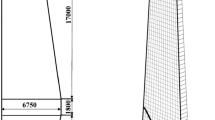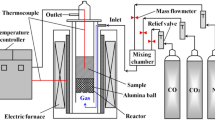Abstract
Charge carbon composite briquette (CCB) is an effective method to reduce CO2 emissions and save energy in blast furnace (BF) ironmaking. Presently with the hydrogen-bearing gas being injected in the BF, the content of H2 and H2O in the BF gas is comparable to those of CO and CO2, and they could not be ignored in analyzing the CCB reaction behavior in the BF shaft. In this research, a mathematical model was developed for analyzing the reaction behavior of CCB under the H2-H2O-CO-CO2-N2 atmosphere. The model was one-dimensional. Chemical reactions, internal gas diffusion, and mass transfer between the CCB and the atmosphere were considered in the model. Using the model, the influence of gas composition and temperature on CCB reaction was discussed and the reaction progress was investigated. The simulation results showed that increasing temperature or increasing hydrogen in the atmosphere can prompt the reduction of iron oxide and the gasification of carbon in CCB. In the investigated temperature range, iron oxide reduction by hydrogen and carbon gasification by water vapor played important roles in the CCB reaction process.
Access this chapter
Tax calculation will be finalised at checkout
Purchases are for personal use only
Similar content being viewed by others
References
Naito M, Takeda K, Matsui Y (2015) Ironmaking technology for the last 100 years: deployment to advanced technologies from introduction of technological know-how, and evolution to next-generation process. ISIJ Int 55(1):7–35
Zhang C, Vladislav L, Xu R, Sergey G, Jiao K, Zhang J, Li T, Aleksei T, Wang C, Wang G (2022) Blast furnace hydrogen-rich metallurgy-research on efficiency injection of natural gas and pulverized coal. Fuel 311:122412
Kasai A, Toyota H, Nozawa K, Kitayama S (2011) Reduction of reducing agent rate in blast furnace operation by carbon composite iron ore hot briquette. ISIJ Int 51(8):1333–1335
Yokoyama H, Higuchi K, Ito T, Oshino A (2012) Decrease in carbon consumption of a commercial blast furnace by using carbon composite iron ore. ISIJ Int 52(11):2000–2006
Okosun T, Nielson S, Zhou C (2022) Blast furnace hydrogen injection: investigating impacts and feasibility with computational fluid dynamics. JOM 74(4):1521–1532
Ren M, Liu W, Zhao J, Zou C, Ren L, Wu H, Zhao J (2023) Effects of hydrogen fraction in co-injection gas on combustion characteristics of the raceway in low carbon emission blast furnace. Int J Hydrogen Energ 48(30):11530–11540
Bernasowski M (2014) Theoretical study of the hydrogen influence on iron oxides reduction at the blast furnace process. Steel Res Int 85(4):670–678
Tang H, Sun Y, Rong T, Guo Z (2021) Reaction model and reaction behavior of carbon composite briquettein blast furnace. Powder Technol 377:832–842
Tang H, Guo Z, Kitagawa K (2012) Simulation study on performance of z-path moving-fluidized bed for gaseous reduction of iron ore fines. ISIJ Int 52(7):1241–1249
Acknowledgements
The authors thank the National Natural Science Foundation of China (No. U1960205), and the State Key Laboratory of Advanced Metallurgy USTB for the financial support of this work.
Author information
Authors and Affiliations
Corresponding author
Editor information
Editors and Affiliations
Rights and permissions
Copyright information
© 2024 The Minerals, Metals & Materials Society
About this paper
Cite this paper
Cheng, S., Tang, H. (2024). Modeling Carbon Composite Briquette Reaction Under H2-H2O-CO-CO2-N2 Atmosphere. In: Iloeje, C., et al. Energy Technology 2024. TMS 2024. The Minerals, Metals & Materials Series. Springer, Cham. https://doi.org/10.1007/978-3-031-50244-6_21
Download citation
DOI: https://doi.org/10.1007/978-3-031-50244-6_21
Published:
Publisher Name: Springer, Cham
Print ISBN: 978-3-031-50243-9
Online ISBN: 978-3-031-50244-6
eBook Packages: Chemistry and Materials ScienceChemistry and Material Science (R0)




